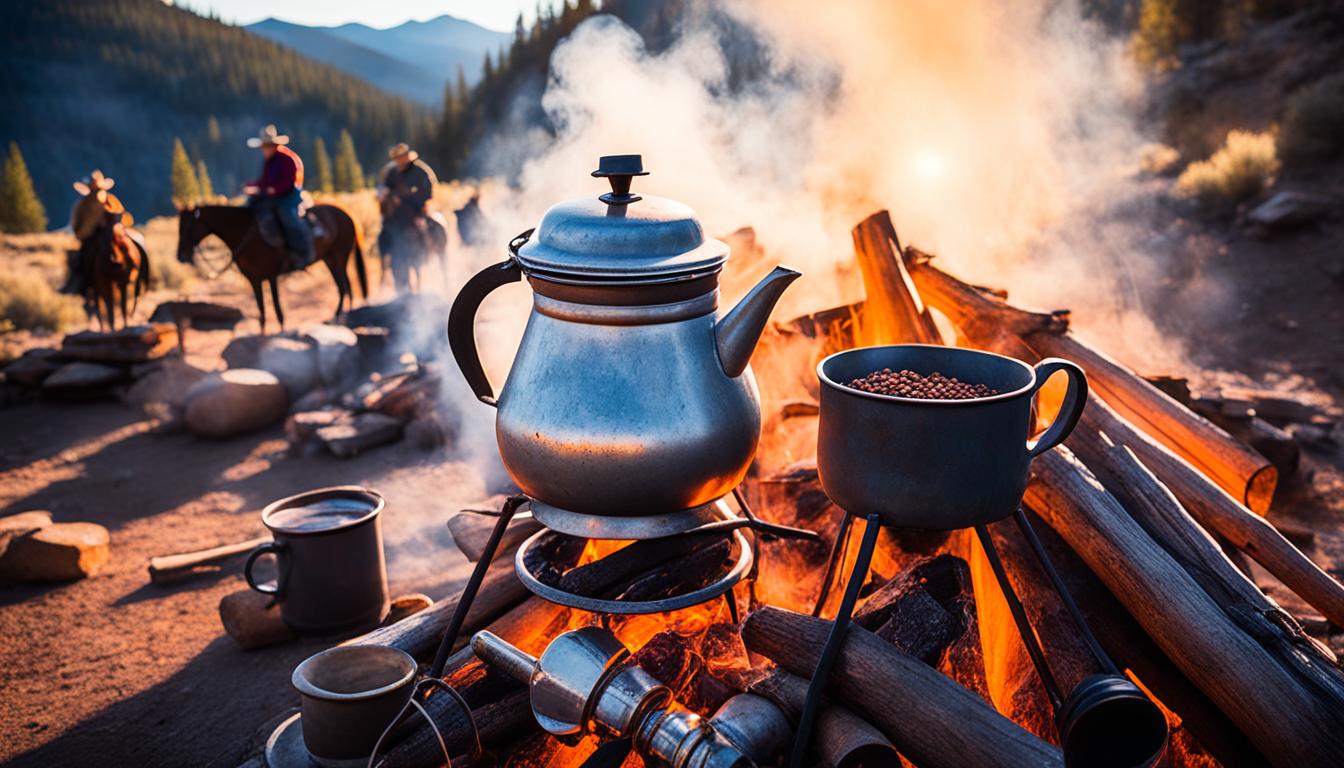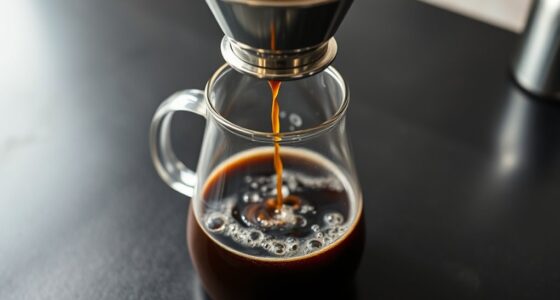Did you realize that coffee is the primary dietary source of caffeine? Have you ever pondered the exact amount of caffeine in your cup? The response could be quite unexpected. Curious to find out more?
The amount of caffeine in a cup of coffee can vary based on several factors, including the type of coffee, serving size, and bean variety. On average, an 8 oz cup of brewed coffee contains about 95 mg of caffeine. But here’s where it gets interesting – the caffeine content in different coffee drinks can range from almost zero to over 500 mg per serving! So, how much caffeine is really in your morning brew?
Key Takeaways:
- The caffeine content in a cup of coffee can vary greatly depending on factors like the type of coffee, serving size, and bean variety.
- An average 8 oz cup of brewed coffee contains about 95 mg of caffeine.
- Other coffee drinks can have significantly higher or lower caffeine content than regular brewed coffee.
- Understanding the caffeine content in your coffee can help you make informed choices and control your caffeine intake.
- Stay tuned to explore the factors that affect caffeine content and discover the caffeine levels in different types of coffee.
Factors That Affect Caffeine Content
The caffeine content in coffee can vary due to several factors. These include the type of coffee beans used, the roasting process, the type of coffee, and the serving size.
Type of Coffee Beans
The caffeine content of coffee is largely determined by the type of beans used. For instance, arabica beans, which are the most commonly consumed and highly regarded, typically contain about 1.2% caffeine by weight. On the other hand, robusta beans have a higher caffeine content of up to 2.2%. However, it’s important to note that variations can exist within each species, influenced by factors such as origin and cultivation methods.
Roasting Process
The roasting process also impacts the caffeine content of coffee. Generally, darker roasts, such as French roast or Italian roast, have less caffeine compared to lighter roasts like City roast or American roast. This is because caffeine is partially destroyed during the prolonged roasting process. So, if you prefer a stronger caffeine kick, opting for a lighter roast would be a better choice.
Type of Coffee
The specific type of coffee you choose can affect the caffeine content as well. For instance, a standard 8 oz cup of regular brewed coffee typically contains about 70-140 mg of caffeine. On the other hand, a 1 oz shot of espresso contains approximately 63 mg of caffeine. Instant coffee usually has less caffeine than regular brewed coffee, with approximately 30-90 mg per cup. Decaf coffee, as the name suggests, goes through a process to remove most of the caffeine, resulting in a significantly lower caffeine content ranging from 0-7 mg per cup.
Serving Size
The serving size of a cup of coffee also plays a crucial role in the total amount of caffeine consumed. A larger cup will naturally have more caffeine compared to a smaller cup size. For example, a 16 oz serving of regular brewed coffee will contain almost double the caffeine content of an 8 oz serving.
| Type of Coffee | Caffeine Content (mg per serving) |
|---|---|
| Regular Brewed Coffee (8 oz) | 70-140 |
| Espresso (1 oz shot) | 63 |
| Instant Coffee (8 oz) | 30-90 |
| Decaf Coffee (8 oz) | 0-7 |
As you can see from the table above, different types of coffee can have varying caffeine contents. Understanding these factors can help you make informed choices about the caffeine content in your daily brew.
Caffeine Content in Different Types of Coffee
Coffee lovers often wonder about the caffeine content in their favorite brews. From the traditional brewed coffee to the bold shot of espresso, each type of coffee has its own unique caffeine profile. Let’s explore the caffeine content in different types of coffee and discover how much caffeine you can expect from each cup.
Brewed Coffee
When it comes to brewed coffee, the caffeine content can vary depending on factors such as the coffee bean variety, roasting level, and serving size. On average, an 8 oz cup of brewed coffee contains about 70-140 mg of caffeine, with an average of 95 mg. This amount may differ based on personal preferences and the specific brewing method.
Espresso
Espresso is famous for its rich flavor and concentration. A 1 oz shot of espresso contains approximately 63 mg of caffeine. When it comes to espresso-based drinks like lattes and cappuccinos, the caffeine content remains consistent with straight espresso. So, whether you’re sipping on a solo shot or indulging in a frothy latte, you can expect the same caffeine boost.
Instant Coffee
Instant coffee, also known as soluble coffee, offers a quick and convenient way to enjoy a cup of joe. However, compared to regular brewed coffee, instant coffee usually contains less caffeine. On average, a cup of instant coffee contains approximately 30-90 mg of caffeine. Keep in mind that the exact caffeine content may vary between different brands and preparations.
Decaf Coffee
Despite its name, decaf coffee still contains a small amount of caffeine. Decaffeinated coffee typically undergoes a process that removes most of the caffeine, but some traces may remain. On average, a cup of decaf coffee contains anywhere from 0-7 mg of caffeine. The exact amount can vary based on the specific decaffeination method used and the brand.
| Coffee Type | Caffeine Content (8 oz cup) |
|---|---|
| Brewed Coffee | 70-140 mg |
| Espresso | 63 mg (per 1 oz shot) |
| Instant Coffee | 30-90 mg |
| Decaf Coffee | 0-7 mg |
It’s essential to note that these figures are general estimates, and the actual caffeine content can vary depending on factors such as coffee bean variety, preparation methods, and brand-specific variations. However, having a rough idea of the caffeine content in different types of coffee can help you make informed choices based on your preferences and caffeine tolerance.
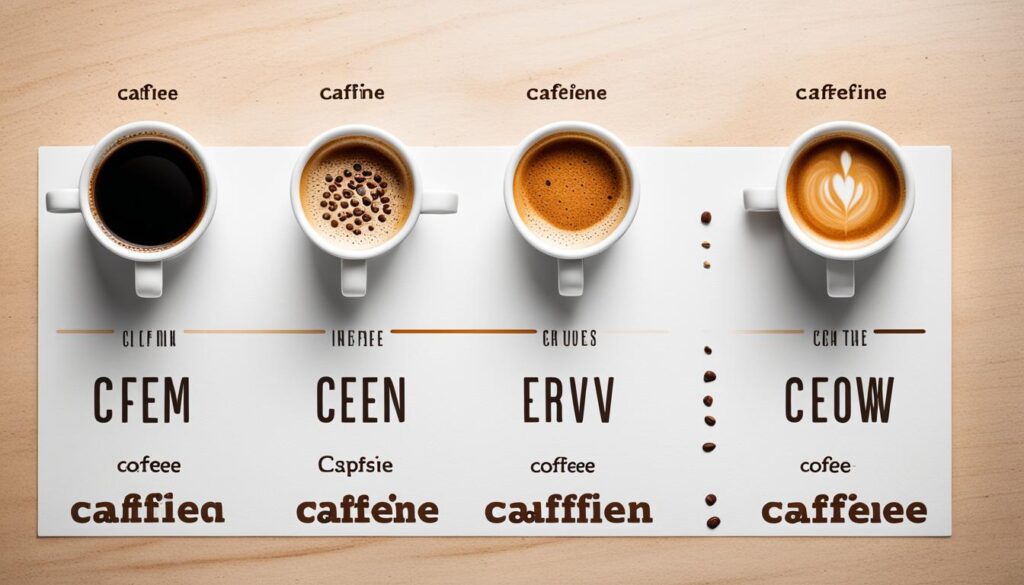
Caffeine Content in Commercial Coffee Brands
When it comes to caffeine content, not all coffee drinks are created equal. Commercial coffee brands like Starbucks, McDonald’s, and Dunkin Donuts offer a range of coffee beverages with varying levels of caffeine to cater to different preferences and needs.
Let’s take a closer look at the caffeine content in some popular coffee offerings from these commercial brands:
| Commercial Coffee Brand | Caffeine Content (8 oz Serving) |
|---|---|
| Starbucks | 180 mg |
| McDonald’s | Varies by cup size and type |
| Dunkin Donuts | 215 mg |
Note: The caffeine content in coffee drinks from these brands may vary depending on the size and type of the beverage. If you are trying to monitor your caffeine intake, it’s important to be mindful of the serving size and the brewing method used for your coffee. Whether you prefer an espresso, a latte, or a drip coffee, perfecting your coffee brewing technique can help you control the caffeine content in your drinks. Additionally, experimenting with different brewing methods such as French press or pour-over can also influence the final caffeine content in your cup of coffee.
Starbucks, a popular coffee chain worldwide, offers a range of caffeinated coffee drinks. An 8 oz cup of their brewed coffee contains approximately 180 mg of caffeine, providing a strong kick to start your day.
McDonald’s, known for its McCafé coffee line, also offers various coffee options with different caffeine levels. However, the exact caffeine content can vary depending on the cup size and type of coffee drink you choose.
Dunkin Donuts is another well-known coffee brand that is beloved by many. Their medium cup of coffee contains around 215 mg of caffeine, providing a bold and energizing experience.
It’s important to keep in mind that caffeine content can vary based on factors such as the size of the cup, the brewing method, and the specific blend used. Therefore, always check the caffeine content information provided by the brand or consult the barista for accurate details.
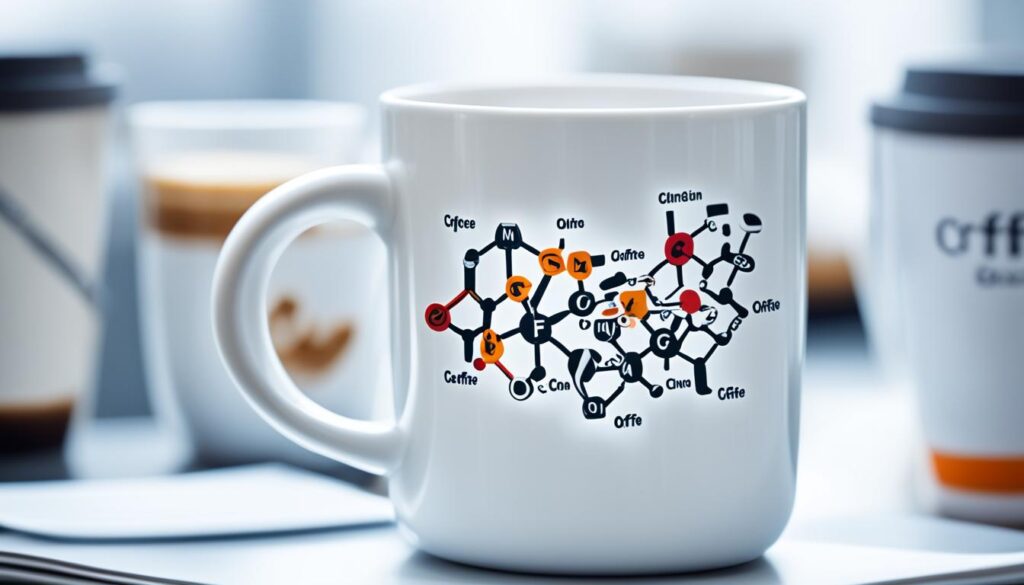
Caffeine Intake and Safety
When it comes to caffeine intake, moderation is key. Consuming moderate amounts of caffeine, which is generally defined as 400-600 mg per day, is considered safe for most healthy adults. This is roughly equivalent to 4-6 cups of coffee.
However, it’s important to note that sensitivity to caffeine can vary between individuals. Some people may experience adverse side effects when consuming even smaller amounts of caffeine, while others may be more tolerant to higher doses. It’s essential to be mindful of personal tolerance levels and listen to your body.
Excessive caffeine consumption can have negative effects on your health. It can cause increased heart rate, restlessness, anxiety, sleep disruptions, and even heart palpitations. It’s crucial to pay attention to how caffeine affects your body and adjust your intake accordingly.
Drinking coffee in moderation can help you enjoy the benefits of caffeine without experiencing adverse effects. It’s also worth noting that caffeine can be found in other sources such as tea, soft drinks, energy drinks, chocolate, and some medications. These should also be considered when calculating your overall caffeine intake.
“Moderation in all things” – Howes
Understanding your personal tolerance to caffeine and consuming it in moderation is key to enjoying your favorite caffeinated beverages without compromising your overall well-being.
Other Sources of Caffeine
Aside from coffee, there are various other sources that can contribute to your caffeine intake. It’s important to be aware of these sources to better manage your overall consumption. Some common alternatives to coffee include:
Tea
Both black and green tea contain caffeine, although the levels can vary. Black tea generally has a higher caffeine content compared to green tea. For those looking for a milder caffeine boost, green tea can be a suitable option.
Soft Drinks
Many soft drinks, particularly colas, are known to contain caffeine. They can provide a quick pick-me-up, but it’s important to be cautious with their consumption as they may also contain added sugars and other additives.
Energy Drinks
Energy drinks are specifically formulated to provide a significant caffeine boost. They often contain high levels of caffeine, along with other stimulants and additives. It’s advisable to limit energy drink consumption due to their potential impact on heart health.
Chocolate
Chocolate, especially darker varieties, contains natural caffeine. Indulging in a small piece of dark chocolate can offer a mild caffeine boost while satisfying your sweet cravings. However, it’s important to consume chocolate in moderation due to its calorie and sugar content.
Medications
Some pain-relieving medications, such as migraine medications and certain over-the-counter pain relievers, may contain caffeine. It’s crucial to read the labels of these medications and consult with a healthcare professional if you have concerns about caffeine sensitivity or potential interactions.
It’s worth noting that the caffeine content in these alternatives may vary depending on the specific brand and product. Therefore, it’s advisable to read labels and consider the caffeine content when making choices. Below is a table summarizing the approximate caffeine content in different sources:
| Source | Caffeine Content (mg) |
|---|---|
| Black Tea (8 oz) | 30-80 |
| Green Tea (8 oz) | 20-45 |
| Cola Soft Drink (12 oz) | 30-50 |
| Energy Drink (8 oz) | 50-80 |
| Dark Chocolate (1 oz) | 20 |
It’s essential to listen to your body and be mindful of your caffeine intake from all sources. Consider your personal caffeine tolerance, potential interactions, and your overall health when making choices.

The Amount of Caffeine in Coffee Beans
When it comes to caffeine content, coffee beans play a significant role. Different species of coffee beans can have varying amounts of caffeine. The most popular type of coffee bean, known as Arabica, typically contains around 1.2% caffeine by weight. On the other hand, robusta beans, which are known for their higher caffeine content, can contain as much as 2.2% caffeine. It’s important to note that there can be variations within each species, depending on factors such as processing and roasting.
Understanding the caffeine content in coffee beans is essential for coffee enthusiasts who want to make informed choices about their brew. Whether you prefer the smoother taste of Arabica or the extra kick of robusta, knowing the caffeine content can help you select the beans that suit your palate and caffeine preferences.
The Caffeine Content of Different Coffee Beans:
| Coffee Bean | Caffeine Content |
|---|---|
| Arabica | Around 1.2% caffeine by weight |
| Robusta | Up to 2.2% caffeine by weight |
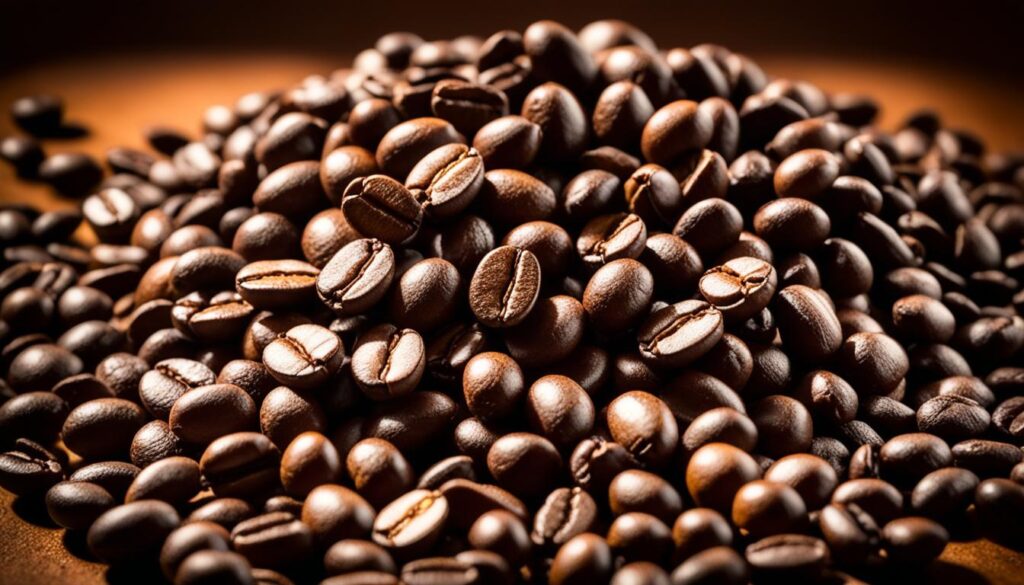
The table above provides a snapshot of the typical caffeine content found in Arabica and robusta coffee beans. However, it’s important to remember that the final caffeine content can also be influenced by other factors, such as the way the beans are processed and the level of roasting.
While Arabica beans are commonly preferred for their smooth and nuanced flavors, robusta beans are often chosen for their bolder taste and higher caffeine content. The choice between the two ultimately depends on personal preference and desired caffeine intake.
So, whether you’re brewing your own coffee at home or selecting beans for your favorite café, being aware of the caffeine content in coffee beans allows you to tailor your coffee experience to your individual preferences and needs.
The Role of Roasting in Caffeine Content
The roasting process plays an essential role in determining the caffeine content of coffee. While the overall volume of caffeine remains relatively consistent, the weight loss of other elements during roasting can affect the percentage of caffeine in different roast levels.
When coffee beans are roasted, they undergo chemical changes that result in the development of various flavor compounds. Some of the compounds that contribute to the unique taste of coffee, including oils and sugars, undergo weight loss during the roasting process. As a result, the concentration of caffeine in the roasted beans increases.
Dark roast coffees, such as French roasts or Italian roasts, are roasted for a longer duration, which leads to a more significant weight loss of other compounds and a higher concentration of caffeine. Therefore, dark roast coffees tend to have a higher caffeine content compared to light roast coffees. While light roast coffees may have less caffeine by volume, the extraction rate of caffeine in lighter roasts is typically lower than in darker roasts. This means that a cup of light roast coffee may not extract as much caffeine as a cup of dark roast coffee.
It’s essential to note that the caffeine content can vary depending on factors such as the type of coffee beans used, the specific roast profile, and even the brewing method. For example, Arabica beans, the most commonly cultivated coffee species, typically have a slightly lower caffeine content than Robusta beans. Additionally, the brewing method can also impact the final caffeine content in a cup of coffee.

Conclusion
The caffeine content in a cup of coffee can vary depending on several factors, including the type of coffee, serving size, and brewing method. On average, an 8 oz cup of brewed coffee contains about 95 mg of caffeine. This information is crucial for coffee lovers who want to make informed choices about their daily brew.
It’s essential to be aware of personal sensitivity to caffeine and to consume it in moderation. While caffeine can provide a boost of energy and enhance focus, consuming too much can lead to side effects such as anxiety and sleep disruptions. It’s recommended to limit caffeine intake to 400-600 mg per day, which is approximately 4-6 cups of coffee.
If you’re looking to reduce your caffeine intake, there are several options available. Decaf coffee is a popular choice as it goes through a process to remove most of the caffeine. Lighter roasts also tend to have less caffeine compared to darker roasts. By choosing decaf coffee or lighter roasts, you can still enjoy the taste of coffee without consuming excessive amounts of caffeine.
Ultimately, understanding the caffeine content in your daily brew empowers you to make informed choices as a coffee lover. Whether you prefer a strong cup of espresso or a milder decaf option, being aware of the caffeine content allows you to tailor your coffee experience to suit your personal preferences and lifestyle.

